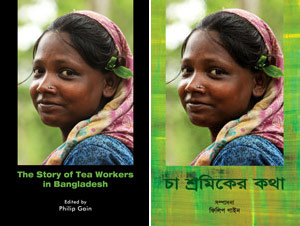
The Story of Tea Workers in Bangladesh
Issues relating to the tea plantation workers and how the tea industry is run. 2009, Paperback – English, 303 pages
Bangla (Cha Sramiker Katha), 334 pages | Tk.300 / US$15
This book is about the tea plantation workers in Bangladesh. However, the genesis of tea cultivation in what is now Bangladesh, its growth, ownership, rights of the tea workers and their struggle for legitimate demands, the use of land granted for tea cultivation and different trends have also been featured to help understand the conditions in which the indentured tea plantation workers have been confined.
The first commercial-scale tea garden in Bangladesh was established in 1854. Now the country has 156 tea gardens (excluding seven in the North Bengal) with more than 118,000 tea workers. The laborers who keep the tea industry alive are not locals. The British companies brought them from different States of India about 150 years back. These workers belonging to many ethnic identities cleared jungles, planted and tended tea saplings, planted shade trees, and built luxurious bungalows for the tea planters. But they had their destiny tied to their huts in the ‘labor lines’ that they built themselves. They continue to remain as people without choice and entitlement to property.
Living conditions in the labor lines of the tea gardens are generally unsatisfactory. Typically a single room is crowded with people of different ages of a family. Cattle and human beings are often seen living together in the same house or room.
The wages of the tea plantation workers of Bangladesh is another concern. They get much lower wages than the Indian tea workers. The work condition of the tea plantation workers is not satisfactory. They are socially excluded, overwhelmingly illiterate, deprived and disconnected. They have also lost their languages and cultures.
“The Story of Tea Workers in Bangladesh” is a book for a wide range of users and actors who want to understand the issues relating to the tea plantation workers and how the tea industry is run. In addition to information, insights and views about the conditions of the tea plantation workers, one will also find significant literature review and guidance to web resources on tea; useful addresses of concerned actors and institutions; laws relating to tea industry and tea workers; a glossary on the tea industry and the tea plantation workers; the demands of the tea workers and the memorandum of understanding; addresses of all the tea estates with some basic information, etc.
Publication Details
Published: 2009
English: 303 pages, Paperback
Bangla: 334 pages, Paperback
Editor: Philip Gain
Price: Tk.300 US$15
